Parent SNP
TMRCA Based on
Parent SNP
Proven Descendant of
R-FT83659 via
BigY500/BigY700
Total Likely Descendants
base on YDNA Tests
Most Interesting Affinity Families
UPDATE:
April 27, 2023 – We have a new member in this group. He descends from a man with the surname of Lyle and the common ancestor appears to be in the early to mid 1200’s (R-A8055). This is quite a leap back and very important. SEE DANNY’S CHART BELOW.
Fall, 2020 – Lynne Sinclair’s brilliant research on the descendants of Sinclair Bottom + DNA SNP work by 3 participants proves they are all descendants of our Herdmanston Lineage. See details at bottom of this page.
Nov 28, 2017 – Our Herdmanston Lineage has benefited from the knowledge of, and work by, Nathan Forrester. Read more below about his assessment of the TMRCA between the Forresters and the St Clairs of Herdmanston.
I’ve always thought this group’s connection was in lowland Scotland or England, but precisely where remained a mystery. It includes families who came through Pennsylvania, Ireland, Virginia and others who apparently never left Scotland.
In Scotland, it goes as far north as Kilchrenan, Argyle and as far east as Leith (1800s). Many of the DNA participants have stories going back to Edinburgh or Rosslyn.
It also includes the Sinclairs of Sinclair Bottom, Virginia.
If a researcher from Richmond is right, then it includes Alexander Sinclair of Augusta County, and he may now be proven to be from Wigton, (Dumfries & Galloway) Scotland.
Closely connected to these folks via DNA is a gentleman named Gregg Wilson who’s doing continual research to look for a connection between these families. He too can show a connection back to Wigton. Several of the photos on this page are from Gregg’s trip to Herdmanston.
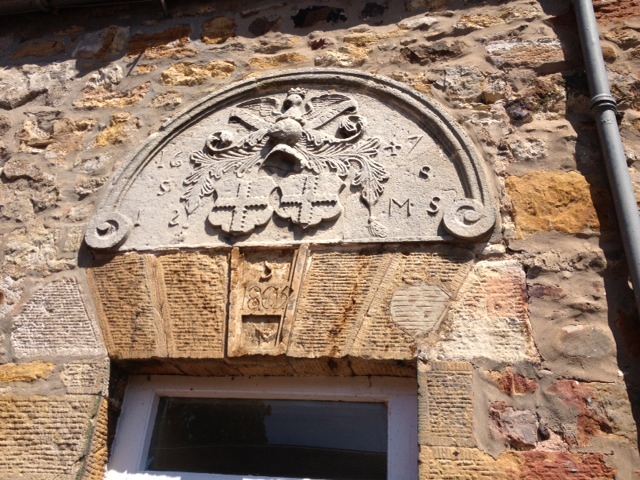
Above is a picture of the portico above the farm’s back door taken from the original manor house.
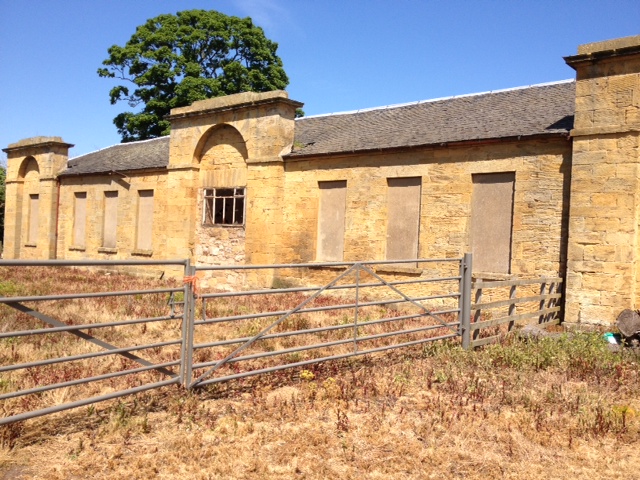 Two photos by Gregg Wilson, a member of our Herdmanston lineage.
Two photos by Gregg Wilson, a member of our Herdmanston lineage.
That’s all we knew, until our Herdmanston participant (who wishes to remain anonymous) agreed to take the DNA test. When his first 12 markers came in, he matched the Mystery Lineage 12 of 12. Then on 25-markers, he matched no one. On 37 markers, he matched no one. Then, on 67 markers, he matched 61 of 67 markers with our Mystery Lineage. Naturally, I waited until the Big Y testing with Yfull verification was complete. It’s a match, and more recent than the Herdmanston’s date of 1162, which is to be expected.
UPDATE: The Herdmanston Lineage has been Big Y tested and the results run through Yfull. We’re now certain their are a matching lineage, along with a gentleman named Wilson and another family named Forrester. The timeframe for this connection is loosely confirmed as the mid-1400s. The Forrrester family are interesting because they fit into the narrative of our family, both in Edinburgh and up in Caithness, however those connections in the narrative are earlier than the current Yfull timeframe can corroborate.
When questioning whether or not our Mystery Lineage are indeed the descendants of the Herdmanston St. Clairs, two other things are in their favour –
If you study the chart above, you can see the split between our P312* (L11), our P312+, and U106+ Saint Clair DNA study members. This split occurred about 2,500 BC. That’s quite a long time ago.
While this doesn’t represent a new branch in our family – after all we’ve had our Mystery Lineage for many years – it confirms that the Herdmanston St. Clairs who came north into Scotland were distinctly different than the others who would follow later, like the Caithness Lineage.
You’ll notice that I don’t given any family a 100% chance of being descended of a particular known historical Lineage in our family. The main reasons are:
• Non-paternity events that weren’t known or went un-recorded
• Purposefully faked records
Some stories of our family, and some evidence, suggest that only one line came north into Scotland. I personally find this too simplistic.
Even if more than one line came north, then there is still some evidence that we should wait until further research on these matters is completed, further DNA is tested, and perhaps even ancient bones are tested.
Father Richard Augustin Hay wrote that the St. Clair family received Herdmanston from Richard de Morville in 1160. Most websites quote Burkes (p. 2625) on this. He stated that the land was given to the St. Clairs in 1162. The website People of Medieval Scotland (see below) quotes the actual document.
On my trip to Herdmanston in October 2012, I noticed a small “chapel” on the grounds. While it looked old, I judged it to have been built in the 1600s based on the graves within. However my friend and extraordinary Sinclair researcher, Rondo B B Me, pointed me to the RCAHMS website on Herdmanston Chapel. This website makes it clear that the chapel at Herdmanston was build in the 1200s by John St Clair. What’s visible today is a well-preserved part of the original building. There are two markers on the ground, and many inserted into the walls that surround the dirt floor. Rondo pointed out that the burials of the family members would have likely been in the Eastern part of the original structure which is no longer there.
The website People of Medieval Scotland has a transcription of the original record – “John de St Clare notes that the abbot and convent of Dryburgh had granted to him that he and his heirs may construct chapels at Herdmanston (in Saltoun ph., ELO) or Carfrae (ELO) and have a chaplain in the same. John promises that the mother churches of Saltoun and Channelkirk shall not incur damages or injury and that all obventions shall be made faithfully and in full. In recognition of the rights of both mother churches, he has also given, granted and by his charter established, to the said abbey two acres of land in his territory of Herdmanston which lie next to their land of Saltoun, which he measured.” (POMS-1)
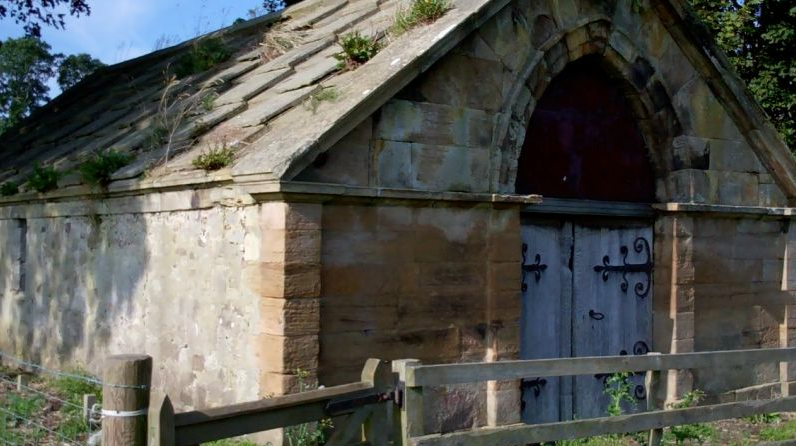
The chapel at Herdmanston. Photos by Steve St. Clair
Inside the chapel are many white marble plaques mounted on the walls, each with its own inscription marking a family member’s passing. On the ground are two more grave markers. These two are obviously the oldest in the building. I recall reading they’re from the 1500s. One has the engrailed cross on it; the other shows 3 roosters around a crescent moon.

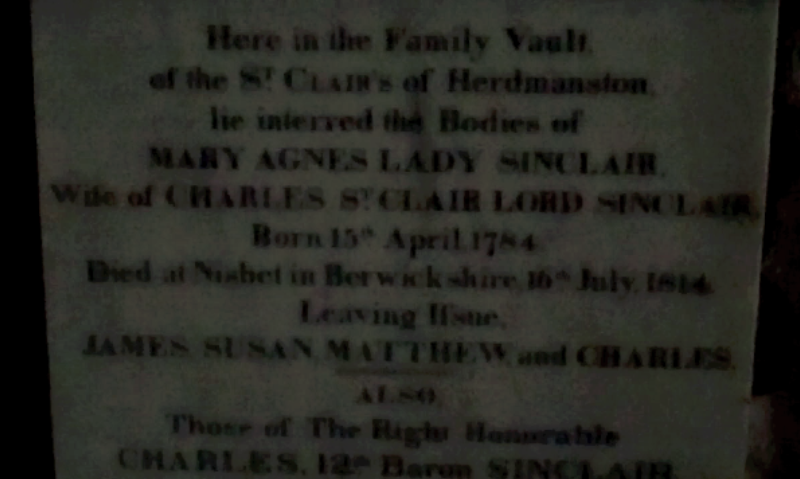
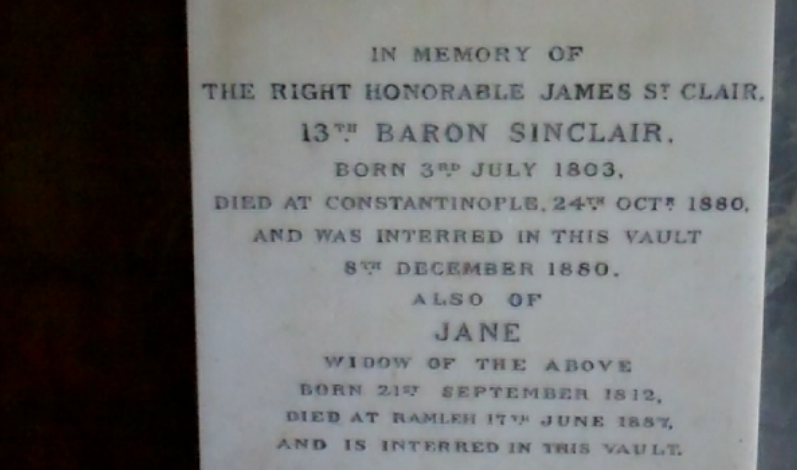
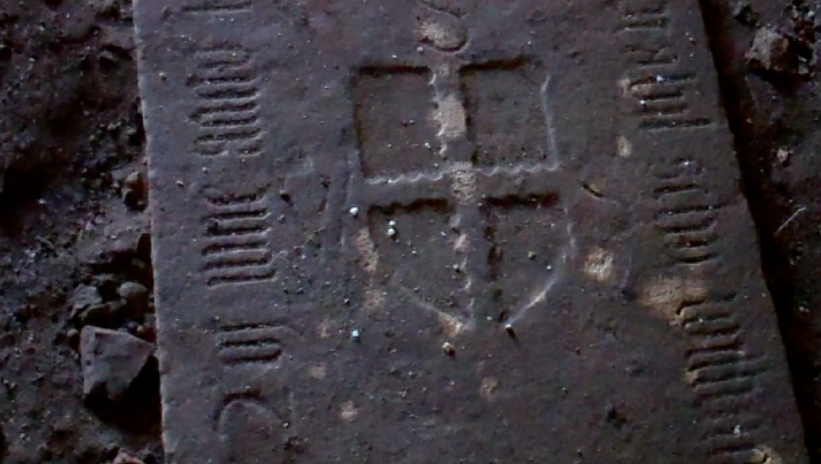
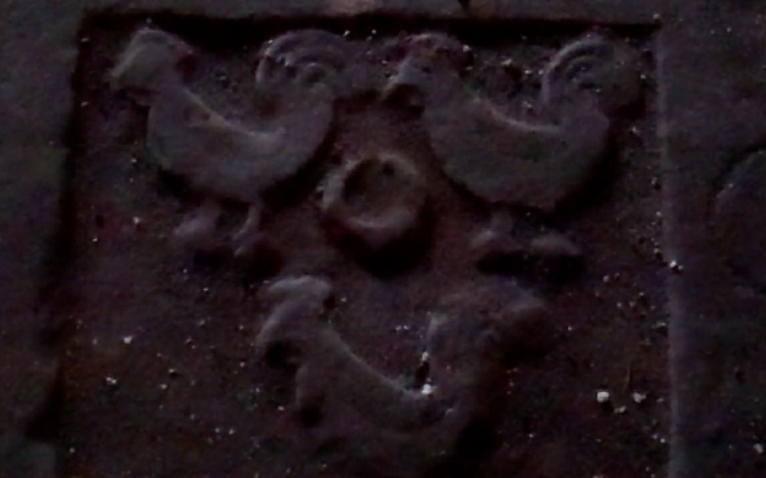
People of Medieval Scotland doesn’t have a ton of records on the St. Clairs of Herdmanston. The main one is from 1162, when the St. Clairs received Herdmanston from Richard de Morville – “Gift of Herdmanston (East Lothian) and other lands.” I find it terribly interesting that this occurred in the same year Hugh de Morville died. They must have been very important to Richard de Morville, but less so to his father, Hugh.
An interesting record connects the de Morvilles (builders of Dryburgh Abbey), the Vaux family, and the St Clairs of Herdmanston. About 1150, John de Vaux became the new lord of Dirleton and built a castle on Fidra Island, just off the coast of Dirleton in the Firth of Forth. In c. 1180, John’s son, William de Vaux granted Fidra to Dryburgh Abbey. Then, c. 1255, Sir Alexander de Vaux issued 5 charters to Dryburgh concerning the island, all of which were witnessed by Henry II Sinclair of Herdmanston.
“Richard de Moreville, constable of the king of Scots, has given and granted to Henry de St Clare and has by this his charter established, Herdmanston (ELO) with all the land that Richard the chamberlain held of Hugh his father and of him, except a half ploughgate of land which he holds in his own hand, and with the aforesaid land he gives him in augmentation, the land lying next to the ‘pomerium’, between ‘Calkesburne’ and ‘Wacellum’ which is on the west side of ‘Berkerie’, in feu and heritage, by the same bounds by which Richard the chamberlain held them, making the service of a quarter part of a knight to himself and his heirs after him. (PoMS 3/416/19)
Who was this ‘Richard the chamberlain’? PoMS identifies him with St Andrews.
A look at the witnesses to the granting of the lands of Herdmanston to the St. Clairs is instructive –
Ace, master of Soutra; Alan of Thirlestane (son of Aelsi); Andrew, priest; Avice of Lancaster, wife of Richard de Moreville (d.1191); Gamel, son of Aelfweald; Gilchrist of Saltoun; Godfrey de Ros (12C); Herbert, priest; Humphrey Malcael; James, son of Lambin of Loudoun; Robert, son of Warnebald (12C); Stephen, son of Richard; William, son of Aldan (12C) (Source PoMS A.Thirlestane)
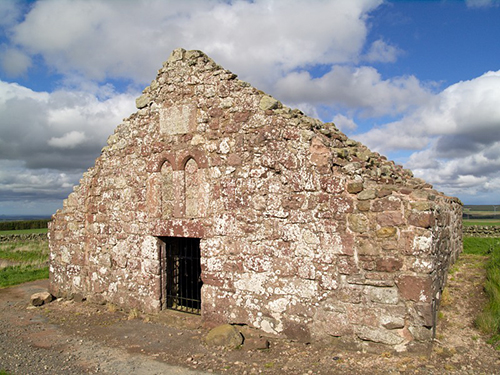
That first witness, Ace Master of Soutra, is very interesting. Soutra is Soutra Hospital (pictured at right). Many different and unrelated people gave lands to important hospitals after they had experienced a recovery from disease there. I’ve been studying this place quite a bit because it was one of the most important hospitals in Scotland at the time. Soutra was founded by king Malcolm IV in 1164 (Wikipedia – Soutra)
Alan of Thirlestane (son of Aelsi, or Aelfsige son of Winter). Elsi was sheriff of Lauderdale, 1162-77. Also known as Alan of Thirlestane, he was a tenant of the de Morville lords of Lauderdale. Note Alan was still alive on 21 May 1203. (Source – PoMS A. Thirlestane)
A witness from Lauderdale, seat of the de Morville family in Scotland, means that the family were extending their influence from a southern base.
Avice of Lancaster was a patron of Melrose Abbey (PoMS-3)
Saint-Clair has the St. Clairs of Herdmanston, particularly one Henry De St. Clair, holding Carfrae in about 1203, when St Clair’s daughter Ada married Petrus de Haga (Haig).
The St. Clairs were granted Herdmanston by Richard de Morville. His father was Hugh de Morville. According to G.W.S. Barrow (one of my favorite scholars of Medieval Scottish history) Hugh was actually named Richard de Morville and was from the commune of Morville in the canton of Bricquebec, Normandy. The Canton of Bricquebec is in the department of Manche (the Cotentin Peninsula), Basse-Normandie.
Hugh de Morville can be assumed to have followed Earl David (later David I) on his arrival back into Northumberland England.
In studying the documents of the Morville family of Scotland, you’ll notice recurrent witnesses named Néhou. There was land named Néhou. It was a commune also in the Manche department of Normandy.
Emondeville is a commune in the Manche department of Normandy.
Montebourg Abbey – Several Morvelles in England gave land to this abbey. William de Moreville donated property to Montebourg abbey, for the souls of his wife Mathildis and his son Eudo. Son Eudo confirmed it in 1174. Roger de Stuteville (Stotvilla) witnessed Eudo’s confirmation. The Stuteville name is quite interesting in our history. Helwis (Heloise) de Stuteville m. Hugh de Moreville. There was more than one Hugh Moreville in northern England. The one who married into the Stuteville family was the Forester of Cumberland. William d’Aubigny (Albini), the Earl of Arundel, granted lands to Montebourg Abbey. In 1175, Gilbert de Hunfrancvilla (Umfranville) gave his chapel of Douna to Montebourg Abbey for the well-being of his soul and those of his family living and dead. Among the witnesses was Philippo le Ver (Vaux).
Bradpole, Dorset – Selside, Kendal, Cumbria – they donated this land to Furness Abbey, or St. Mary of Furness, a Cistercian abbey (LOTN-1)
Richard and Avice de Morville held land in Northamptonshire, Huntingdonshire, and Rutland of the honor of Huntingdon (Harleian p. 49)
Lands in Northumberland – Granted lands in Northumberland England when David, Prince of the Cumbrians, earl of Huntingdon, (later David I), moved from Normandy (where he held lands of Henry I of England) to Northumberland, England.
Northumberland
Burgh-by-Sands
Lauderdale
Dryburgh
Saltoun
Herdmanston
Hugh was from Morville, near Valognes, and appears around 1115 in the entourage of David, earl of Huntingdon, the future David I (d.1153). He had lands centred on Bozeat, Northamptonshire, and Whissendine, Rutland. He was appointed constable of King David by November 1140 and received a fief at Lauderdale, and probably the lordship of Cunningham, with Largs. Hugh founded the Premonastratensian abbey of Dryburgh around 1150-52. Hugh married Beatrice de Beauchamp, whose family was from Bedford, and with her had three sons: Hugh (d.1173/74), lord of north Westmorland, who was one of the murderers of Thomas Becket; Richard (d.1189/90), who inherited the constableship and lands; Malcolm, who was killed by 1174 and buried in Leicester Abbey; and two daughters: Ada, who married Roger Bertram, lord of Mitford; and Maud, who married William de Vieuxpont (d.in or bef. 1203). Hugh the elder died in 1162, shortly after he had taken the canonical habit at Dryburgh, where he presumably died. (Source – PoMS Morville)
Their source – [http://www.oxforddnb.com/view/article/19378]
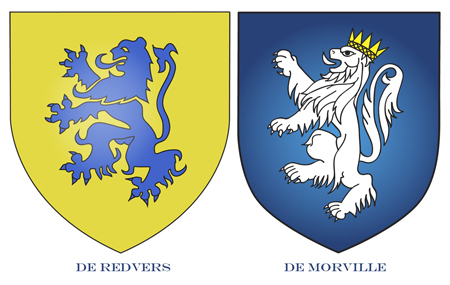
The name Richard de Morville in medieval England can be confusing. Domesday Descendants (p. 603) lists 3 different gentlemen by the name. But even this is confusing. They have –
(1) a Ricardus de Morville as a witness to a charter of Richard de Redvers c. 1100. They go on to say this proves his line goes back to an area called Morvilles, arr. Valognes, comm. cant. Bricquebec, Manche. (their source, Loyd, p. 70)
(2) Richard de Morville, son of Herbert de Morville. In 1166, he held 5 fees of Roger de Mowbray, including Collingham. His wife was Alice de Percy. Early Yorkshire Charters, Percy Fee (p. 364) states that this Richard gave lands in Collingham to St. Peter’s hospital in York.
(3) Richard de Morville, son of Hugh de Morville (later Constables of Scotland) and his wife Beatrice de Beauchamp. This is the Richard who gave the St. Clair family Herdmanston. Richard married Avice, daughter of William of Lancaster and widow of William II Peverel of Nottingham (d. 1154). He died in 1189 leaving a son, William and a daughter, Helen, who married Roland fits Uctred of Galloway. (Domesday Descendants, p. 603)
What I find interesting is #1 and #3 above. I’ve read that Hugh de Morville went by the name Richard in some documents. That makes good sense, because either (a) I’ve found strong connections between the Morville constables of Scotland and the Redvers family, or (b) the connections between families and benefactions are too strong to leave to coincidence. The connection became clear to me thanks to the Néhou family. I’ve seen them show up in (1189 X 1196) as witnesses to documents of the Morville family. (PoMS-W.Morville, PoMS-A. Néhou, etc.) The land called Néhou was the main possession of the de Redvers in the Cotentin. Clearly that’s where Alexander de Néhou, Richard de Néhou, and William de Néhou got their surname.
Barrow (Kingdom, p. 285) has William de Néhou witnessing a mid-12th century grant by William de Morville of the chapel of Bradpole in Dorset to Montebourg Abbey. Guess who’s buried at Montebourg Abbey? Richard de Redvers. His father, Baldwin de Redvers, founded Quarr Abbey on the Isle of Wight. William de Morville was a witness to the founding of Quarr Abbey in 1161. (Hampshire, p. 296)
Geoffrey Barrow (Kingdom p. 265) states that Lauder was the caput of the Morville lordship. The Morville fief in Scotland was the largest held of the crown by private land holders. The Morvilles were also the only people in Scotland with the title Vicecomes (sheriff).
The Charters of David I have Richard de Morville witnessing a gift of Richard de Redvers to Montebourg abbey. So the connections to Normandy were still strong.
Barrow (Kingdom, p. 285) says the surname Morville is from Brix, just south-west of Brix. They were vassals of the Honour of Vernon in Normandy. In fact, you’ll see the surname Vernon show up in some records involving the Morvilles.
Early Charters (p. 274) says Hugh and Beatrix de Bellocampo had at least 4 children – (1) Richard, (2) Malcolm, killed in a hunting accident, (3) Roger, a.k.a. Robert, and (4) Ada.
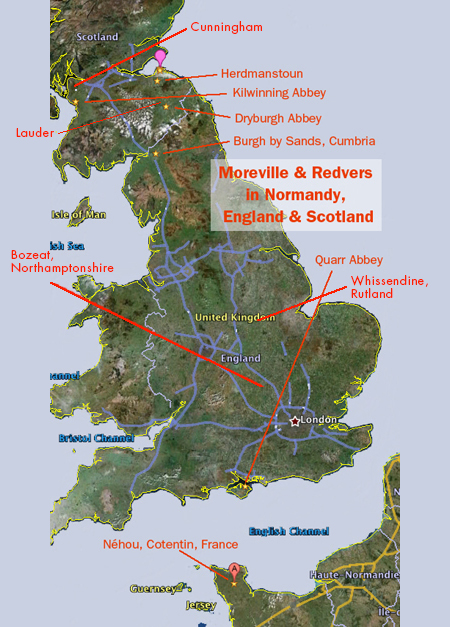
Richard held land in Yorkshire (Early Yorkshire, p.364, etc.). He may have been the Richard who gave land to Salley Abbey. The abbey at Sallay (Sawley) was a Cistercian house founded in 1147 by the Percy family. close to the Yorkshire-Lancashire border. (Sallay Chartulary, p. 28) The Percy family, of course, were incredibly powerful in 12th Century England.
Barrow has an interesting paragraph in “Kingdom of the Scots.” He quotes the names that Sir Thomas Grey said came with William the Lion: “It was into William the Lion’s reign, and in particular to the period immediately following the Treaty of Falaise (1174), that later Scottish tradition, if correctly reported by Sir Thomas Grey, assigned a sudden and massive tidal wave of Norman immigration into Scotland, bringing with it the families of Balliol, Bruce Soules, Moubray, Sinclair, Hay, Giffard, Ramsay, Laundells, Bisset, Barclar, Valognes, Boys, Montgomery, Vaux, Colville, Fraser Graham, Gourlay and several more. and then goes on to make clear that Grey left out names like Lovel, Frivill, Lascelles, Kernelle, Montfort, Revel, and Normanville.”
Rondo pointed out that we shouldn’t place too much reliance on this list – for example the Bissets were in Scotland in King David’s time and the Montgomereys say they came in with Walter FitzAlan from Wales in King David’s time, and Sir Simon de Ramsay witnessed King David’s charters.
Of course, we know the St Clairs already held Herdmanston for 12 years by 1174. And we know the Rosslyn Sinclairs were over a century away from being granted Rosslyn (1279). So, if Sir Thomas Grey and Barrow are right, and a lineage came with William the Lion, were they one of our existing lineages? Which one?
Richard de Moreville was the son of Hugh de Moreville (d.1162) and his wife, Beatrice de Beauchamp. He succeeded to the constableship of Scotland in 1162. He founded the Tironensian abbey of Kilwinning, Cunningham, and established St Leonard’s Hospital at Lauder. Richard married, by 1170, Avice (Avicia) (d.1191), daughter of William of Lancaster, lord of Kendal, which brought him an estate on Burton in Lonsdale. He also had a manor and park at Whissendine, Rutland, and Scottish lands centred in Lauderdale and Cunningham. With Avice, he had one son, William (d.1196), and one daughter, Helen (d.1217), who transferred the constableship and estates to her husband, Roland, lord of Galloway (d.1200). Richard died in 1189 or 1190. (Source – PoMS)
Richard de Morville inherited his role as Constable of Scotland upon the death of his father, Hugh de Morville, in 1162. Richard went on to witness many important charters of Malcolm IV – 34 to be exact (Barrow, Regesta, p. 6). Amazingly little has been written about Richard de Morville. One gets the feeling that he was not as important as his father, but this is likely not the case.
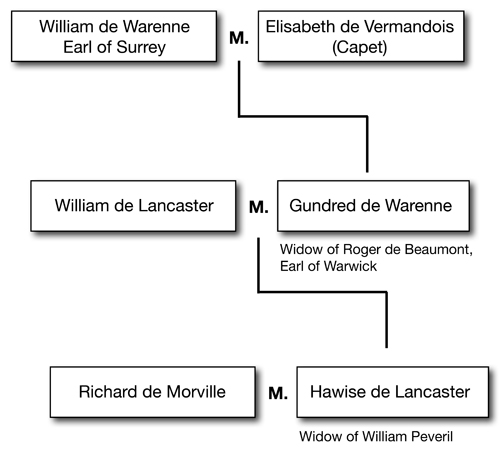
There are several differing accounts of how the genealogy works for Richard de Morville’s wife. Here are two examples –
The FMG website says – “As can be seen from the chronology of William de Lancaster´s known wife Gundred de Warenne, this affiliation would only be possible if Hawise had been born from an otherwise unrecorded earlier marriage. On the other hand, the onomastics are favourable, as each succeeding generation of this “de Lancaster” family included a Hawise de Lancaster. ”
Maitland – Barry (p. 22-23) has William Mautalent (Maitland) witnessing a bequest to St. Mary’s York by Alan, lord of the manor of Kirby Misperton in the North Riding. A man of the same name also witnessed a charter for Lanercost Priory in Cumberland by Hugh son of Simon de Morville, lord of Burgh-by-Sands.
Néhou – If you study the records of the Morville family in Scotland, a regular surname was witnessing many of their land transfers – Néhou. The Néhou family were from the Cotentin. A place named Néhou was the principal land of the de Redvers in the Cotentin.
Clues may be found in the similarities of armorial bearings. The Lion Rampant was on the shields of many other families with origins in Normandy.

In the back of a small but important book by Lewis C. Loyd is a list of tenants in chief in Normandy and those families who held land of them in England. “Origins of Some Anglo-Norman Families” is a critical resource for anyone doing genealogy work in Medieval England.
He lists the Reivers (Redvers) family and their tenants. The list is short – Roliot, Lestre, Moreville, Oglander.
So, naturally, I go to the P312 project (see sources below) and take a look for these names in the SNP matches. Up pops a participant who claims an ancestor, “Albert Toussaint Liser, b.1896, Lamentin Martinique” from France. Liser and Lestre could be variants of the same surname. Also, another test subject who claims an ancestor, “Humphry DeOgle, 1055-1155, Ogle, England.” That could certainly be a variant of Oglander. The timeframe of the P312 mutation is quite old, so I make no claims here. But it’s a definite line to dig into.
Montebourg Abbey – Stapleton has Richard de Reviers (Redvers) buried at 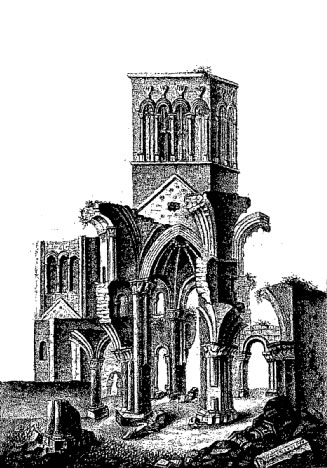 Montbourg Abbey (right) in 1107.
Montbourg Abbey (right) in 1107.
Quarr Abbey – Quarr is on the Isle of Wight off the coast of Southern England. By Domesday, Richard de Redvers held almost all the land on the Isle of Wight and many other manors. The Morville family, having been granted their land in England by the Redvers, also were benefactors to Quarr Abbey.
When William Rufus died in 1100 and Henry received the throne, Richard de Redvers became an important advisor. King Henry was the 4th and youngest son of William the Conqueror. His older brothers William Rufus and Robert Curthose jointly inherited England (William) and Normandy (Robert). Henry received no lands. These three had many disputes. For instance, Henry had purchased the Cotentin from Robert, but later lost it again. Henry eventually found an ally in William. (Wiki – Henry I)
The Herdmanston Lineage owes a lot to King Henry I. It was he who guided the career of Scotland’s king David I.
“King Henry’s brother William II ‘Rufus’, was killed in a hunting accident in August 1100. Henry had himself crowned a few days later while his brother Robert was away on crusade. With a number of barons supporting Robert, however, Henry’s succession was precarious. He moved quickly to buy support by granting favours, abolishing abuses and making wide-ranging concessions in his Charter of Liberties. In November 1100, he married Edith, sister of king Edgar of Scotland. This marriage is believed to have been an attempt by king Henry to secure his northern borders.” (BBC History Website, Henry I) Edith and Edgar were the older siblings of king David I.
In 1120, Henry I was in Normandy. He put his son and heir, William Adelin on the White Ship to return to England. The ship sank, William died, and the resulting chaos of succession became known as The Anarchy. King Henry now had only one heir, Matilda. The barons were not comfortable with what would be the first female queen in her own right. At Henry’s death in 1135, Stephen of Blois, Henry’s nephew, usurped the thrown and was king of England from 1135 to 1154. (Dunbar p. 58 – 61)(Wikipedia – David I)
King (pages not numbered) has a nice account of the ascension of King Stephen (‘of Blois’) in 1135. But I’m left confused by the list of witnesses to the crowning of Stephen of Blois. They include Simon de Senlis and Hamo de St Clair.
“noble officers of the household: the constables Robert de Vere [Vaux], Miles of Gloucester, Robert d’Oilly, and Briad Fitz Count; the stewards William Martel, Hugh Bigod, Humphrey de Bohun, Simon de Beauchamp, Robert Malet, and Robert Fitz Richard de Clare; the butlers William d’Aubigny and Eudo Martel; the chamberlains: Aubrey de Vere [Vaux?], and William de Pont-de-l’Arche. There there are the barons Robert de Ferrers, William Peverel of Nottingham, Simon of Senlis, Geoffrey de Mandeville, William d’Aubigny Briton, Payn Fitz John, Hamo de St Clair, Ilbert de Lacy, Geoffrey Talbot, Walter Espect, Roger of Valognes, Henry de Port, Walter Fitz Richard de Clare, Walter de Gant, Walter de Bolebec, Walchelin Maminot, William de Percy.” (source) (King, pages not numbered)
During the Anarchy, David I supported Matilda, King Henry’s daughter and David’s niece. Their closeness would prove beneficial to David. So it was no coincidence that, in 1139, Matilda granted Northumberland north of the Tees to David I of Scotland.
The rise of David, youngest son of Malcolm III of Scotland and Margaret of Wessex, brother-in-law of King Henry I of England, Prince of the Cumbrians from 1113 to 1124, Earl of Northampton and Huntingdon and finally, David I King of Scots is complex and well worth studying. Richard Oram’s book, “David, the King Who Made Scotland” is one of my favorite sources on the rise of David. This part of the story is important to understand because David brought Hugh de Morville into great power with him in Scotland. Hugh’s son Richard de Morville granted the St. Clairs of Herdmanston the first recorded land any of our Sinclair / St. Clair Lineages held in Scotland. To understand these St. Clairs of Herdmanston fully means we must solve where they came from and when; because the timing seems to run counter to the research by Father Richard Augustin Hay and Roland W. Saint-Clair.
Being the youngest of several sons of Malcolm III, David’s future was uncertain until he was about 17 years old. On January 8th, 1107, Edgar, king of Scotland and David’s brother, died. This thrust David into an entirely new and important role in supporting his brother-in-law, King Henry I of England. Henry had married David’s sister, Edith (known as Matilda after the marriage). (Oram, p. 57)
Earl David married Maud (or Matilda) de Senlis in c. 1113. This was her second marriage. Maud’s first husband, Simon de Senlis (Barrow Charters p. 59). Her marriage to de Senlis would have large implications for Scotland. The Senlis family had their origins in the first capital of the Capetian kings of France. This was the ancient home of the counts of Vermandois. Beryl Platts (p. 70-71) has a wonderful section on this in one of her books. Later, as King David I of Scotland, David brought many Flemish up into Scotland. Richard Oram (p. 105) backs up Platts saying the Flemish settlement of Scotland was planned, and the arrival of the man known as Freskin was the apex of that “occupation.” He goes on to suggest that the Flemings were already settling in Innes and Nether Urquhart in the reign of Malcolm IV. Moray seems to have been in the center of the Flemish settlement.
David’s marriage to Maud de Senlis, Countess of Huntingdon and Northampton, gave him Northumberland, which made David and earl. Rondo wrote, “David received Cumbria from his older brother Edgar as an appanage – these were the southern counties of modern Scotland – Roxburghshire, Selkirkshire, Berwickshire, Peeblesshire and Lanarkshire. , He received Northumberland from his wife. He then incorporated Cumberland and Westmorland as well as Northumberland as we know it today.” This land would prove important for David I and directly effected the future of the St Clairs of Herdmanston.
When Malcolm IV, grandson of King David I, became king in 1153, he was 12 years old. He died at age 25, December 9, 1165 at Jedburgh as a result of poor health that plagued him all his life. Given that he was king of Scotland in 1162 when Richard de Morville granted Herdmanston to the St Clairs, we would do well to understand him better.
The best source I know of for Malcolm IV’s relatively short reign is G.W.S. Barrow’s “The Acts of Malcolm IV King of Scots 1153 – 1165. Malcolm was the oldest of 3 sons of Henry, earl of Northumberland, only son of King David I of Scotland. (Barrow, p. 3)
I get the distinct feeling that Scotland was still considered the hinterlands at this point, just shy of 100 years since the Norman Invasion. After all, it was during reign of Malcolm’s grandfather, David I, that Scotland finally become feudalized. David, Henry and Malcolm all seem to have been oriented from Northumberland, facing North, and having close allegiances with England to the south.
Malcolm did not found many religious houses. But he did found a Cistercian monastery at Coupar Angus. I have found no association with Coupar Angus and the St. Clairs of Herdmanston.
Often, when a modern day Sinclair was found in Southwest Virginia who could trace back to the late 1800s, they were lumped into the Alexander Sinkler line due to the spelling of their name and their geographic proximity. Sinclair Bottom has never been an easy area to figure out. We have one member in our project who was told unequivocally that he was descended of Alexander Sinkler of 1698 (the L193 Lineage). His DNA told a different story. His DYS390=23 was a major clue that something wasn’t right. That and his genetic closeness to two others who know they’re of the Sinclair Bottom line proved his true path.
In Smythe County, on the South Fork of the Holston River lies land that was originally surveyed for Charles St. Clair in 1753. (Banes)
“In the spring of 1754, numbers of families were obliged, by an
Indian invasion, to remove from their settlements in Southwest Virginia,
and these removals continued during the entire war [French-Indian War].
It will be well here to note the fact that the lands held by Stephen
Holston, James McCall, Charles Sinclair and James Burke, the earlier
settlers of this portion of Virginia, were held by them under what were
known at that time as ‘corn rights’–that is, under the law as it then
stood, each settler acquired title to a hundred acres for every acre
planted by him in corn…”
(Summers, p 134) (Charles)
The Sinclair Bottom group has been proven to be descendants of Herdmanston. Lynne Sinclair, son of Charles Sinclair did very solid research on his genealogy and proved he goes back to Charles of Sinclair Bottom. They have close ties to Kilchrenan, Scotland, with members of this line showing up in Ireland, Pennsylvania, Virginia and some staying in Scotland.
Read up on Lynne Sinclair’s amazing work. Click here >>
Anonymous, “Calendar of Documents Preserved in France: Illustrative of the History of Great Britain and Ireland. A.D. 918-1206, Volume 1,” Edited by J. Horrace Round, M.A., Printed for Her Majesty’s Stationery Office by Kyrk and Spottiswoode, printers to the Queen’s Most Excellent Majesty. 1899
Banes – First person research in the Papers of Henry Banes.
Barrow, G.W.S., “The Kingdom of the Scots” published by Edward Arnold (Publishers) Ltd. 1973 ISBN 0 7486 1802 3
Barrow, G.W.S., “The Charters of King David I: The Written Acts of David I King of Scots” Boydell Press, Jan 1, 1999, Reprinted 2008 ISBN 9-780-85115-731-3
Barrow, G.W.S., “Regesta Regum Scottorum, Volume I” The Edinburgh University Press, 1960
Barry, T.B., “COLONY & FRONTIER IN MEDIEVAL IRELAND: Essays Presented to J.F.Lydon” Continuum International Publishing Group, Nov 1, 2003
BBC History Website, Henry I
Bearman, Robert, “Baldwin de Redvers: Some Aspects of a Baronial Careen in the Reign of King Stephen” A paper published in “Proceedings of the Battle Conference 1995” edited by Christopher Harper-Bill, Boydell & Brewer Ltd, 1996 ISBN 0 85115 666 5
Burke’s Peerage & Baronetage, 106th Edition, Charles Mosley Editor-in-Chief, 1999. Page: 2625
Charles – Website – Monday 06/17/2002 12:52 pm
http://www.curtisit.com/curtis/colyer/charles_sinclair_information.html
Chartulary of the Cistercian Abbey of St Mary of Sallay in Craven, edited by Joseph McNulty, Cambridge University Press, 2013
Cassell, Petter, “Our own country, descriptive, historical, pictorial,” Galpin & Co., London, (year unknown)
Chronicle of Melrose “Chronica de Mailros, ed., notulis aucta” edited by Joseph Stevenson
Doherty, Hugh, “Robert de Vaux and Roger de Stuteville, Sheriffs of Cumberland and and Northumberland, 1170 – 1185.” A paper for the Battle Conference 2005. Printed in “Anglo-Norman Studies XXVIII: Proceedings of the Battle Conference 2005” edited by Christopher Piers Lew
Dunbar, Sir Archibald Hamilton “Scottish Kings: A Revised Chronology of Scottish History, 1005-1625” D. Douglas, 1899
Early Scottish charters: prior to A.D. 1153, edited by Archibald Campbell Lawrie, published by James Maclehose and Sons, Glasgow, 1905
Early Yorkshire Charters: Volume 11, The Percy Fee, edited by William Farrer, Charles Travis Clay, published by Cambridge University Press, 1963 ISBN 978-1-108-05834-6
FMG-1 website – Untitled English Nobility – http://fmg.ac/Projects/MedLands/ENGLISHNOBILITYMEDIEVAL3P-S.htm
FMG – Website – “Foundation for Medieval Genealogy” website as of April 12, 2013
Green, Judith A., “Henry I: King of England and Duke of Normandy” Cambridge University Press, 2006 ISBN: 13 978-0-521-59131-7
Hampshire Field Club and Archaeological Society, “Proceedings, Volume 3” edited by the Rev. G. W. Minns, LL.B., F.S.A., Printed “Hampshire Independent” 1898
Harleian Society, “The publications of the Harleian Society, Volume 103,” Harleian Society, 1951
King, Edmund, “King Stephen,” Yale University Press, 2010 ISBN 978-0-300-11223-8
LOTN-1 “Lands of the Normans” Website
Loyd, Lewis C., “Origins of Some Anglo-Norman Families,” edited posthumously by Charles Travis Clay and David C. Douglas, originally published as Volume CIII of The Publications of the Harleian Society, Leeds, England, 1951, re-published by Genealogical Publishing Co., Inc. Baltimore, 1975
Lyttelton, George, “The History Of The Life of King Henry the Second, And of the Age in which He Lived…” printed by Sandby and Dodsley, 1767
Open Domesday – website
Oram, Richard “David I, The King Who Made Scotland” The History Press, 2004, 2008 ISBN 978 0 7509 4672 1
P312 (including P310) SNP project website
Platts, Beryl, “Scottish Hazard, the Flemish Nobility and their Impact on Scotland, Volume I” Procter Press, London 1985 ISBN 0 906650 01 X
PoMS-1 – John de St Clare chapels at Herdmanston (in Saltoun)
PoMS-2 People of Medieval Scotland website – Alan of Thirlestane
PoMS-3 People of Medieval Scotland website – Avice of Lancaster
PoMS 3/416/19 – Document 3/416/19 (APS, i, 94) – Amanda Beam, John Bradley, Dauvit Broun, John Reuben Davies, Matthew Hammond, Michele Pasin (with others), The People of Medieval Scotland, 1093 – 1314 (Glasgow and London, 2012), https://www.poms.ac.uk/record/source/5959/ [accessed 28 September 2019]
PoMS-W.Morville – “Death of William de Morville” William de Moreville, constable of the king of Scots, has given and granted, and by his charter established, to James [son of Lambin] of Loudoun, the land of Loudoun (AYR), by stated bounds, to hold outwith forest and free from forest, of William and his heirs, in feu and heritage, for the service of one knight.” Among the witnesses were Richard de Néhou, Christiana de Morville (wife of William), William Mansell, Alan of Thirlestane, Peter Haig, Henry Sinclair (of Herdmanston), the son and chaplain of Earl Duncan of Fife.
PoMS-A. Néhou – “Death of William de Moreville × death of Roland of Galloway” People of Medieval Scotland – Alexander de Néhou, for the souls of his lords Richard de Moreville, William de Moreville, Roland of Galloway and Helen de Moreville, and William de Néhou his father and Richard de Néhou his brother and Syrit his mother, and others, has granted, given, and by this his present charter established, to Dryburgh Abbey, one half ploughgate of land in the territory of Giffen (AYR), by stated bounds, in free, pure and perpetual alms, with common pasture and other easements of his land of Trearne (AYR). He will allow the canons’ men dwelling on that land to go to the shielings as his men of Trearne do, if they wish. He has granted and given this half ploughgate of land to the canons in exchange for two oxgangs of land which William his father gave them in the feu of Giffen and for two other oxgangs of land which Richard his brother gave and enchartered (incartavit) and for the increase of the land Richard his brother gave them. (Source)
PoMS-H.Morville – “Hugh de Morville” People of Medieval Scotland
R1b1a2 (P312- U106-) DNA Project Website (aka ht35 Project) A Family Tree DNA website
RCAHMS – website – “Royal Commission on the Ancient and Historical Monuments of Scotland”
Saint-Clair, Roland William, The Saint-Clairs of the Isles, being a History of the Sea-Kings of Orkney and their Scottish Successors of the Sirname [Surname]of Sinclair,” H. Brett, General Printer and Publisher, Shortland and Fort Streets, Auckland, N.Z., 1898.
Stapleton, Thomas, “Magni rotuli Scaccarii Normanniae sub regibus Angliae: contains “the later Roll of Richard I. (1198) and the detached membranes of Rolls of the time of King John” (1201-1203) In addition, each volume contains “Observations on the Great rolls of the Exchequer of Normandy,” with full indexes. The general “Index of persons and places,” intended to form a third volume, was never published” sumptibus Soc. antiq. Londiniensis, 1844
This book looks like a tremendous resource on the Redvers family.
Summers, Lewis Preston, “History of Southwest Virginia, 1746-1786, Washington County, 1777-1870” (Baltimore, MD: Genealogical Publishing Company, 1966)
Washington Website – “Some Descendants of the Morville Family Related to George Washington…”
Wikipedia – David I
Wikipedia – Henry I
Wikipedia – Soutra